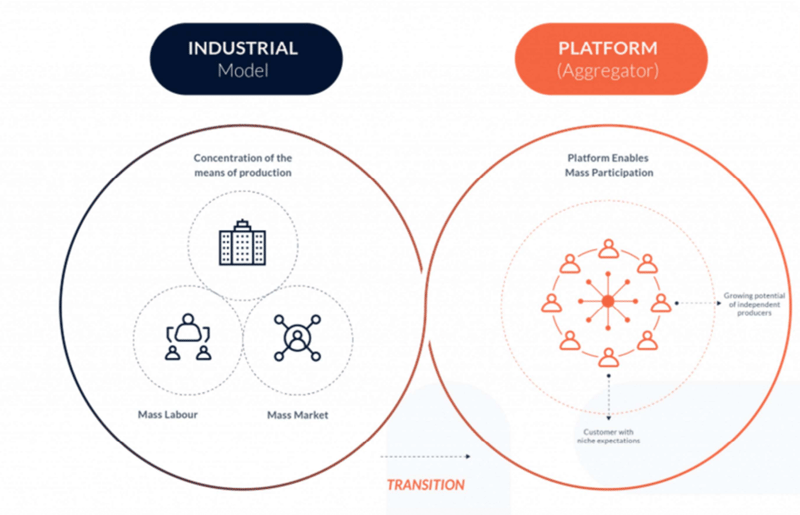We live in disruptive times. The world is changing rapidly, and it’s clear that the future is not simply an extrapolation of the past. It’s nothing new to say that we live in a VUCA (Volatile, Uncertain, Complex, Ambiguous) world. But if the future is so unpredictable, how should we deal with it? And how can we, as an organisation, organise ourselves in a way that is resistant to this unpredictability?
Flexible and dynamic organizing in disruptive times requires a paradigm shift.
A shift:
- from ‘managing’ to ‘self-managing’ (and facilitating this self-managing capability);
- from a focus on the individual to a focus on relationship, interaction, and the whole (which is more than the sum of its parts);
- from a problem-solving approach to discovering and strengthening hidden potential.
In need of a different approach?
In disruptive times, underlying patterns, values, and norms shift. If we continue to build on an outdated reality, tension will emerge sooner or later. Much of today’s organising is based on assumptions and patterns that originated in the industrial revolution. To understand this, let’s look back at the industrial model.

Source: www.boundaryless.io
An industrial model is based on:
- centralising the means of production;
- cheap and low-skilled labor that has to be managed;
- and a large, uniform market.
These assumptions often don’t apply today.
- Means of production are currently very accessible. Today, many jobs are knowledge-based and can easily be organised decentrally.
- Employees are often highly educated; they don’t want to be managed or only carry out tasks. Autonomy and fulfillment are becoming increasingly important when it comes to job satisfaction. With today’s technology, work can increasingly be disconnected from a specific employer. For example, many of the elements needed to start your own business can be found online (LinkedIn and YouTube for marketing, matchmaking platforms, etc.), which makes people less inclined to work for an organisation.
- More and more customers want a product that responds explicitly to their needs, in their specific context, rather than a general product.
Platforms such as Airbnb, Uber, Amazon, Deliveroo, etc. respond to this changed reality and do things differently.
The paradigm shift
Below, we list three concrete paradigm shifts that can make a platform solution an answer in these disruptive and changing times.
1. The shift from managing to self-managing
A platform has few staff of its own. The people who really create value for the ‘customers’ are the platform’s users. Consider Airbnb again: they do not own real estate; they are not hosts. What they do is create an enabling framework to make the necessary interactions as smooth as possible. Nobody controls the Airbnb hosts and tells them what to do, when to start working, or what time guests should check in or out. The framework facilitates and enables the self-managing potential for all these stakeholders.
The enabling framework consists of two important elements: the transaction engine and the learning engine.
The purpose of the transaction engine is to keep the transaction threshold (the transaction cost) as low as possible. A typical example is a marketplace where producers (of goods as in the case of Amazon or services as in the case of Airbnb) and consumers find each other more easily. The development of a user-friendly app is also part of an enabling framework that makes interactions easier.
The learning engine aims to equip users with the skills required to perform their role to the best of their ability and keep the ecosystem’s dynamically evolving potential alive.
- Think of Airbnb’s community calls for hosts, encouraging them to exchange experiences and tips. Or Airbnb’s support from a professional photographer to take good pictures of the house, articles with tips, coaching, etc.
- At the same time, the platform designer keeps his finger on the pulse to see what new opportunities can evolve along with the changing context.

Source: www.boundaryless.io
By tapping into the ecosystem’s self-managing capability, the uniqueness of each of the providers can be used to their full potential. Again, the example of Airbnb: each host is unique, not only in terms of location, but also the style of the house and its availability.
2. The shift from the individual to the relationship, the whole and the ecosystem
A platform approach looks at the ecosystem (the interactions between the stakeholders involved) and gains insights into which interactions are trying to emerge but have not yet been achieved because of barriers. It does not focus on the individual; it focuses on the whole. And when that whole works together smoothly, it is much more than the sum of its parts.
Take the Airbnb platform, for example. For the host, it’s a marketing platform, a booking tool, a community, an experience exchange, a review system, etc. The fact that all these elements come together and reinforce each other is what makes it so attractive.
Because it shifts the focus to the bigger picture, it automatically shifts the focus from a customer-centric, problem-solving approach to exploring the potential of the ecosystem.
3. Shift from solving problems to unleashing (hidden) potential
A platform revolves around enabling interactions so that the potential already present in the ecosystem can develop further. A platform will never “invent” an ecosystem. The ecosystem already exists, and by looking closely and discovering where the barriers are, you can act as a facilitator to bring out the potential.
It’s a dynamic process. Platform designers pick up on signals, see what is already trying to happen, and build on this. It’s a “solution” that emerges and is informed by the context itself. It’s not something that is conceived in an isolated context and then has to be “implemented”.
As Dave Snowden, an expert in complexity thinking, professor, consultant, and creator of the Cynefin framework, puts it: “The next generation of organizing will consist of context-specific solutions that emerge and are continuously adjusted based on a coherent whole.”
The fact that many producers can develop their own services independently also means that when the context changes, an unexpected event occurs, or when a new need arises, these stakeholders can take the initiative to make adjustments. The solution is therefore dynamic element that can adapt to the ever-changing context. An interesting example of this is how people supported Ukrainians by booking a weekend in Ukraine on Airbnb without actually going there.
More than business strategy
Thinking in terms of ecosystems, their interrelationships and hidden potential can be applied in various fields. A similar design approach can be used when developing policies. The government is also shifting from a controlling to a facilitating role. The learning engine approach provides valuable insights into the design of a facilitating framework and rules, and also into managing the behavior of the stakeholders. The policy does not impose tasks but provides supportive measures to mobilise all the stakeholders in the desired direction.
These three paradigm shifts may help to better cope with unexpected complex challenges in the future, such as the reception of Ukrainian refugees.
Platforms, ethics, and a thriving society
The world doesn’t necessarily need more Ubers or Amazons. The paradigm shift behind platforms is very powerful and should be used wisely. If the power of that shift is utilized from the paradigm of competition, outdoing each other, and win-lose thinking, then we are not improving as a society. If a platform extracts a disproportionate amount of value from the ecosystem, then the platform developer is robbing the ecosystem of its own value and, in the long term, undermining its own breeding ground.
What is sustainable, is to work in a facilitative way from the paradigm of co-creation and win-win thinking, which takes the well-being of the entire ecosystem into account. Then the power of platform thinking is utilized in something that helps to advance our society in transition.
Conclusion
Three paradigm shifts that can help us respond dynamically to complex and changing contexts. Three paradigm shifts that can help us set up a powerful facilitating framework and rules. Three paradigm shifts that can be used to promote cooperation and co-creation and create a win-win for society as a whole.
Would you like to explore how these paradigm shifts can enrich your organisation? Do you want to tap into the hidden potential of your ecosystem and build a thriving society? Then get in touch.












